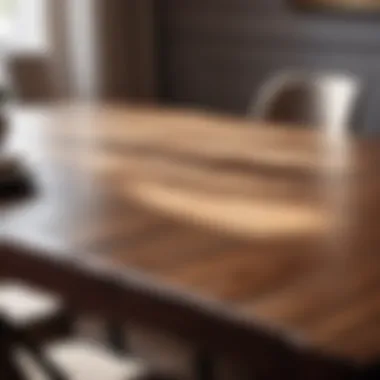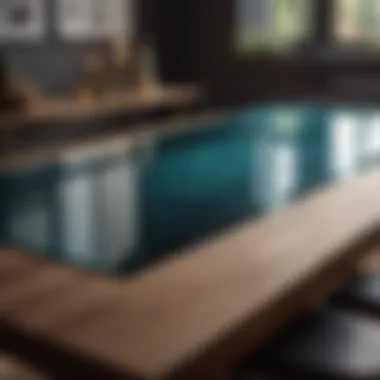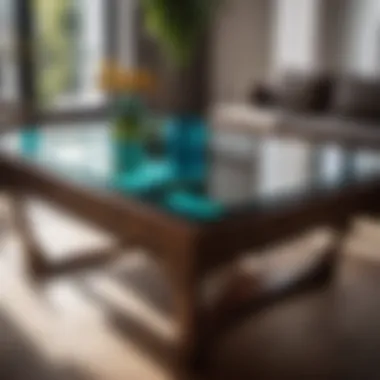Materials:
- Wooden table (dimensions: 4ft x 2ft x 3ft)
- Tempered glass sheet (dimensions: 4.5ft x 2.5ft)
- Glass standoffs (4 pieces)
- Glass adhesive
- Protective gloves
- Measuring tape
- Pencil
- Screwdriver
- Level
DIY Steps:
-
Begin by measuring the dimensions of your wooden table (4ft x 2ft x 3ft) accurately.
-
Choose a tempered glass sheet that fits slightly larger than your table's surface (4.5ft x 2.5ft) for a sleek overhang look.
-
Place the glass sheet carefully on top of the table to ensure it aligns correctly with the edges.
-
Mark the spots where the glass standoffs will be mounted to support the glass.
-
Drill pilot holes on the marks for the standoffs using a screwdriver and ensure they are level.
-
Attach the glass standoffs securely to the wooden table using a screwdriver.
-
Apply a thin, even layer of glass adhesive on top of the table before gently laying the tempered glass sheet on it.
-
Allow the adhesive to dry as per the manufacturer's instructions.
Technical Aspects:
- For a seamless installation, ensure all measurements are precise and accurate to avoid any gaps.
- The choice of tempered glass provides durability and safety for everyday use.
- Using protective gloves is crucial when handling glass to prevent any injuries.
- Checking the level of the glass standoffs is essential for a balanced and stable glass top.
DIY Project Process:


Start assembling the materials on a clean, flat surface. Measure twice, cut once to avoid wastage and ensure a perfect fit. Always follow the manufacturer's guidelines for adhesive application and drying times to achieve a flawless finish. In case of any unevenness or issues during installation, adjust the standoffs accordingly for a level glass top. Regular maintenance of the glass surface with appropriate cleaning products will preserve its clarity and shine, enhancing the overall aesthetics of your wooden table with a glass top.
Troubleshooting Tips:


- If the glass sheet does not align correctly, double-check the measurements and adjust the position before securing it with adhesive.
- In case of adhesive spillage, wipe it off immediately with a damp cloth to prevent it from hardening and affecting the appearance of the glass top.
Introduction


Adding a glass top to a wooden table is a design choice that can elevate the aesthetics and functionality of your furniture. This comprehensive guide will walk you through the process of transforming a simple wooden table into a sophisticated centerpiece for your living space. By understanding the benefits and considerations associated with this upgrade, you can make informed decisions to achieve a seamless integration of glass into your decor.
Benefits of Adding a Glass Top
Enhanced Aesthetic Appeal
Enhancing the aesthetic appeal of your wooden table with a glass top brings a modern and elegant touch to your interior design. The sleek finish and transparency of glass add a sense of sophistication to any room, creating a visual focal point that complements various decor styles. The clean lines and reflective surface of a glass top provide a contemporary aesthetic that is both timeless and versatile. While glass may require more frequent cleaning to maintain its pristine appearance, the effort is minimal compared to the lasting beauty it brings to your space.
Protects the Wooden Surface
One of the key benefits of adding a glass top to a wooden table is the protection it offers to the underlying surface. The glass acts as a barrier against scratches, moisture, and daily wear and tear, preserving the integrity of the wood for years to come. This protective layer ensures that your table retains its original quality, making it a worthwhile investment in extending the lifespan of your furniture. Additionally, the transparency of glass allows the beauty of the wood grain to shine through, enhancing the natural charm of your table.
Easy Maintenance
Maintaining a wooden table with a glass top is relatively easy compared to other surface options. The smooth, non-porous nature of glass makes it resistant to stains and spills, simplifying the cleaning process. A quick wipe with a damp cloth is usually all that is needed to keep your glass top looking crystal clear. This low-maintenance feature saves time and effort, allowing you to enjoy your table without the stress of extensive upkeep. With regular care, your glass top will remain in pristine condition, showcasing the beauty of your wooden table effortlessly.
Considerations Before Proceeding
Table Size and Shape
Before proceeding with adding a glass top to your wooden table, consider the size and shape of the piece. The dimensions of the table will dictate the size of glass needed, ensuring a proper fit and proportional look. Rectangular, round, or oval tables may require different glass shapes to align with the table's design. Taking accurate measurements and consulting with professionals can help you determine the most suitable glass size and shape for optimal visual impact and functionality.
Glass Thickness
Selecting the appropriate thickness of glass is crucial in ensuring the durability and stability of your tabletop. Thicker glass provides additional strength and support, ideal for heavy daily use or larger tables. Thinner glass, while lightweight and elegant, may be more suitable for decorative or occasional tables. Considering the intended use and placement of the table will help you choose the right glass thickness to withstand regular wear and maintain its resilience over time.
Budget Constraints
When planning to enhance your wooden table with a glass top, it is essential to establish a budget that accommodates your design goals and financial considerations. Setting a clear budget from the outset can guide your selection of glass types, finishes, and installation methods. Whether opting for premium tempered glass or budget-friendly alternatives, aligning your choices with your budget constraints will help you achieve a balance between quality and affordability in transforming your table into a stunning focal point for your home.
Choosing the Right Glass
Choosing the right glass for your wooden table is a critical decision that can significantly impact the aesthetic appeal, functionality, and durability of the finished piece. The type of glass you select will dictate not only the look of the table but also its practicality and maintenance requirements. To ensure a successful transformation of your table, it is vital to understand the various types of glass available and their unique characteristics, benefits, and considerations.
Types of Glass
Tempered Glass
Tempered glass is known for its exceptional strength and safety features, making it a popular choice for tabletops. The key characteristic of tempered glass is its ability to shatter into small, blunt fragments upon impact, reducing the risk of serious injury. This feature makes it a practical and safe option for households with children or pets. Additionally, tempered glass is highly resistant to scratches and heat, ensuring long-term durability and easy maintenance. While tempered glass is slightly more expensive than other types, its superior strength and safety properties make it a worthwhile investment for a glass tabletop.
Annealed Glass
Annealed glass is the most common type of glass used for tabletops due to its affordability and versatility. Unlike tempered glass, annealed glass does not undergo the same heat treatment process, making it easier to cut and customize to fit the dimensions of your table. However, annealed glass is more prone to breakage and forms large, sharp shards when shattered, posing a potential safety hazard. Despite its lower price point, annealed glass may require more frequent replacements and careful handling to prevent accidents.
Laminated Glass
Laminated glass consists of two or more layers of glass bonded together with a layer of polyvinyl butyral (PVB) sandwiched between them. This construction provides added safety features as the glass remains intact even when shattered, thanks to the interlayer holding the broken pieces in place. Laminated glass offers excellent protection against UV rays, noise reduction, and enhanced security, making it a premium choice for tabletops in high-traffic areas. While laminated glass is more expensive than annealed glass, its durability, safety benefits, and soundproofing qualities make it a worthwhile investment for those seeking a resilient and secure tabletop option.
Glass Finish Options
Clear Glass
Clear glass offers a timeless and elegant look, allowing the beauty of the wood beneath to shine through while providing a sleek and modern finish to the table. Its transparency creates an illusion of space, making it an ideal choice for smaller rooms or minimalist decor. However, clear glass is more prone to showing fingerprints, smudges, and scratches, requiring regular cleaning and maintenance to preserve its pristine appearance.
Frosted Glass
Frosted glass adds a touch of sophistication and privacy to your tabletop while diffusing light to create a soft, diffused glow in the room. The frosted finish conceals fingerprints and smudges effectively, making it a practical choice for high-traffic areas or homes with young children. Its textured surface not only enhances grip but also reduces the visibility of dust and watermarks, simplifying upkeep and maintenance.
Tinted Glass
Tinted glass offers a contemporary and stylish alternative to clear or frosted options, allowing you to customize the color and opacity of the tabletop to suit your decor preferences. The tinted finish adds a subtle pop of color to the room while reducing glare and UV exposure, creating a comfortable and visually appealing environment. However, tinted glass may slightly obscure the view of the wood underneath and requires careful consideration of lighting and surrounding decor to ensure a cohesive and harmonious design scheme.
Preparing the Wooden Table
When it comes to enhancing a wooden table with a glass top, the first crucial step is preparing the wooden surface. This section is vital as it sets the foundation for the entire transformation process, ensuring a seamless integration of the glass top onto the table. Preparing the wooden table involves two key aspects: sanding and refinishing. By paying close attention to these elements, you can enhance the longevity and aesthetics of your table significantly.
Sanding and Refinishing
Sanding the Surface
Sanding the surface of the wooden table is a critical step in creating a smooth and even base for the glass top. This process entails removing any imperfections such as bumps, rough patches, or old finishes, ensuring a pristine surface for the glass to sit on. By sanding the surface meticulously, you not only improve the visual appeal of the table but also guarantee a secure attachment for the glass top. The key characteristic of sanding the surface lies in its ability to enhance the overall sleekness and elegance of the table, providing a polished look that complements the glass top perfectly.
Choosing the Right Finish
Selecting the appropriate finish for the wooden table is essential as it not only enhances the table's aesthetics but also offers protection against moisture, scratches, and daily wear and tear. Whether opting for a glossy, matte, or satin finish, choosing the right one can elevate the overall design of the table while providing added durability. The unique feature of selecting the right finish is its ability to showcase the natural beauty of the wood while safeguarding it from potential damages. However, it's essential to weigh the advantages and disadvantages of different finishes to ensure the chosen one aligns with both your aesthetic preferences and practical needs.
Measuring and Cutting
After sanding and refinishing the wooden table, the next step involves precise measurements and cutting to accommodate the glass top. Accurate measurements are vital to ensure that the glass fits perfectly on the table, avoiding any overhangs or gaps. Professional cutting tips come into play when shaping the glass to match the table dimensions flawlessly. By following these tips, you can achieve a seamless integration of the glass top, enhancing the overall look and functionality of your wooden table.
Accurate Measurements
Accurate measurements play a crucial role in the success of adding a glass top to a wooden table. By measuring the dimensions meticulously, you can avoid any discrepancies that may arise during the installation process. The key characteristic of accurate measurements lies in its ability to ensure a tailored fit for the glass top, lending a custom-made appearance to the table. This precise approach not only enhances the visual appeal of the table but also guarantees a snug and secure placement of the glass.
Professional Cutting Tips
Professional cutting tips offer valuable insights into shaping the glass top with precision and accuracy. These tips encompass techniques such as using the right tools, cutting along marked lines, and ensuring smooth edges for a professional finish. The unique feature of professional cutting tips is their ability to elevate the overall aesthetics of the table by providing a seamless transition between the wooden surface and the glass top. However, it's essential to consider the advantages and disadvantages of each cutting technique to achieve the desired result seamlessly.
Installing the Glass Top
Adding a glass top to a wooden table is a transformative process that not only enhances the overall look but also adds practicality and durability. When it comes to installing the glass top, attention to detail is key. Ensuring a secure attachment and taking care of the final touches plays a significant role in the success of this project.
Attaching the Glass
Choosing the Right Adhesive:
In the process of attaching the glass, selecting the correct adhesive is paramount. Opting for a high-quality adhesive that is specifically designed for glass-to-wood adhesion is crucial. The adhesive must provide a strong and lasting bond to ensure the glass remains securely in place. One popular choice is UV-cured adhesive, known for its quick curing time and strong adhesion properties. Its unique feature lies in its ability to cure rapidly when exposed to UV light, making it an ideal option for this project. While it offers excellent bonding strength, it is essential to handle it with care due to its light-sensitive nature.
Securing the Glass in Place
Securing the glass in place is the final step in the installation process. The method chosen to secure the glass will depend on the specific table design and personal preference. Utilizing metal clips or brackets to hold the glass in place is a common approach. These fixtures ensure that the glass remains stable and prevents any shifting or sliding. The key characteristic of using metal clips or brackets is their reliability, providing both support and stability to the glass top. Although effective, one drawback is the potential visible hardware, which some may view as a minor aesthetic concern.
Final Touches
Cleaning the Glass
Once the glass top is securely attached, maintaining its clarity and cleanliness is essential. Using a glass cleaner and a soft, lint-free cloth is recommended for routine cleaning. The key characteristic of glass cleaner is its streak-free formula, leaving the surface sparkling without residue. Regular cleaning not only enhances the visual appeal of the glass but also extends its lifespan by preventing buildup or damage.
Adding Decorative Elements
To elevate the look of the table further, incorporating decorative elements can enhance its aesthetic appeal. Simple additions like a table runner, decorative coasters, or a centerpiece can complement the glass top beautifully. The key characteristic of adding these elements is their ability to personalize and style the table to suit individual preferences. While these decorative touches can enhance the overall look, it's important not to overdo it to maintain a balanced and stylish appearance.





